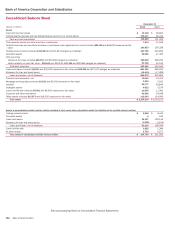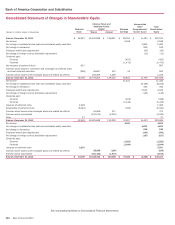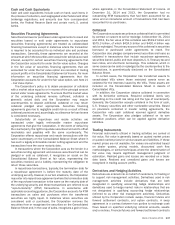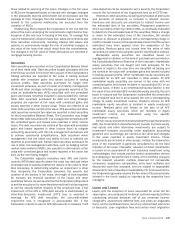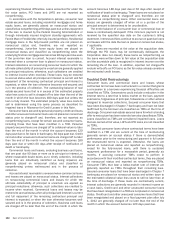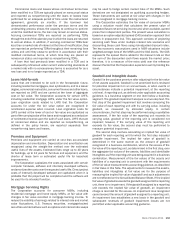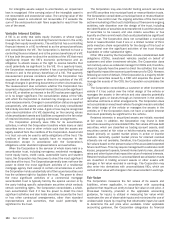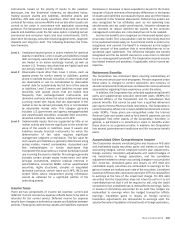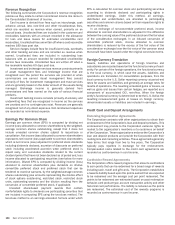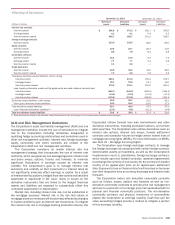Bank of America 2014 Annual Report Download - page 152
Download and view the complete annual report
Please find page 152 of the 2014 Bank of America annual report below. You can navigate through the pages in the report by either clicking on the pages listed below, or by using the keyword search tool below to find specific information within the annual report.150 Bank of America 2014
costs are deferred and recognized as adjustments to interest
income over the lives of the related loans. Unearned income,
discounts and premiums are amortized to interest income using
a level yield methodology. The Corporation elects to account for
certain consumer and commercial loans under the fair value option
with changes in fair value reported in other income (loss).
Under applicable accounting guidance, for reporting purposes,
the loan and lease portfolio is categorized by portfolio segment
and, within each portfolio segment, by class of financing
receivables. A portfolio segment is defined as the level at which
an entity develops and documents a systematic methodology to
determine the allowance for credit losses, and a class of financing
receivables is defined as the level of disaggregation of portfolio
segments based on the initial measurement attribute, risk
characteristics and methods for assessing risk. The Corporation’s
three portfolio segments are Home Loans, Credit Card and Other
Consumer, and Commercial. The classes within the Home Loans
portfolio segment are core portfolio residential mortgage, Legacy
Assets & Servicing residential mortgage, core portfolio home
equity and Legacy Assets & Servicing home equity. The classes
within the Credit Card and Other Consumer portfolio segment are
U.S. credit card, non-U.S. credit card, direct/indirect consumer and
other consumer. The classes within the Commercial portfolio
segment are U.S. commercial, commercial real estate, commercial
lease financing, non-U.S. commercial and U.S. small business
commercial.
Purchased Credit-impaired Loans
The Corporation purchases loans with and without evidence of
credit quality deterioration since origination. Evidence of credit
quality deterioration as of the purchase date may include statistics
such as past due status, refreshed borrower credit scores and
refreshed loan-to-value (LTV) ratios, some of which are not
immediately available as of the purchase date. Purchased loans
with evidence of credit quality deterioration for which it is probable
that the Corporation will not receive all contractually required
payments receivable are accounted for as purchased credit-
impaired (PCI) loans. The excess of the cash flows expected to be
collected on PCI loans, measured as of the acquisition date, over
the estimated fair value is referred to as the accretable yield and
is recognized in interest income over the remaining life of the loan
using a level yield methodology. The difference between
contractually required payments as of the acquisition date and the
cash flows expected to be collected is referred to as the
nonaccretable difference. PCI loans that have similar risk
characteristics, primarily credit risk, collateral type and interest
rate risk, are pooled and accounted for as a single asset with a
single composite interest rate and an aggregate expectation of
cash flows. Once a pool is assembled, it is treated as if it was one
loan for purposes of applying the accounting guidance for PCI
loans. An individual loan is removed from a PCI loan pool if it is
sold, foreclosed, forgiven or the expectation of any future proceeds
is remote. When a loan is removed from a PCI loan pool and the
foreclosure or recovery value of the loan is less than the loan’s
carrying value, the difference is first applied against the PCI pool’s
nonaccretable difference. If the nonaccretable difference has been
fully utilized, only then is the PCI pool’s basis applicable to that
loan written-off against its valuation reserve; however, the integrity
of the pool is maintained and it continues to be accounted for as
if it was one loan.
The Corporation continues to estimate cash flows expected to
be collected over the life of the PCI loans using internal credit risk,
interest rate and prepayment risk models that incorporate
management’s best estimate of current key assumptions such as
default rates, loss severity and prepayment speeds. If, upon
subsequent evaluation, the Corporation determines it is probable
that the present value of the expected cash flows has decreased,
the PCI loan is considered to be further impaired resulting in a
charge to the provision for credit losses and a corresponding
increase to a valuation allowance included in the allowance for
loan and lease losses. The present value of the expected cash
flows is then recalculated each period, which may result in
additional impairment or a reduction of the valuation allowance.
If there is no valuation allowance and it is probable that there is
a significant increase in the present value of the expected cash
flows, the Corporation recalculates the amount of accretable yield
as the excess of the revised expected cash flows over the current
carrying value resulting in a reclassification from nonaccretable
difference to accretable yield. Reclassifications from
nonaccretable difference can also occur if there is a change in the
expected lives of the loans. The present value of the expected
cash flows is determined using the PCI loans’ effective interest
rate, adjusted for changes in the PCI loans’ interest rate indices.
Leases
The Corporation provides equipment financing to its customers
through a variety of lease arrangements. Direct financing leases
are carried at the aggregate of lease payments receivable plus
estimated residual value of the leased property less unearned
income. Leveraged leases, which are a form of financing leases,
are reported net of non-recourse debt. Unearned income on
leveraged and direct financing leases is accreted to interest
income over the lease terms using methods that approximate the
interest method.
Allowance for Credit Losses
The allowance for credit losses, which includes the allowance for
loan and lease losses and the reserve for unfunded lending
commitments, represents management’s estimate of probable
losses inherent in the Corporation’s lending activities. The
allowance for loan and lease losses and the reserve for unfunded
lending commitments exclude amounts for loans and unfunded
lending commitments accounted for under the fair value option as
the fair values of these instruments reflect a credit component.
The allowance for loan and lease losses does not include amounts
related to accrued interest receivable, other than billed interest
and fees on credit card receivables, as accrued interest receivable
is reversed when a loan is placed on nonaccrual status. The
allowance for loan and lease losses represents the estimated
probable credit losses on funded consumer and commercial loans
and leases while the reserve for unfunded lending commitments,
including standby letters of credit and binding unfunded loan
commitments, represents estimated probable credit losses on
these unfunded credit instruments based on utilization
assumptions. Lending-related credit exposures deemed to be
uncollectible, excluding loans carried at fair value, are charged off
against these accounts. Write-offs on PCI loans on which there is
a valuation allowance are written-off against the valuation
allowance. For additional information, see Purchased Credit-
impaired Loans in this Note. Cash recovered on previously charged-
off amounts is recorded as a recovery to these accounts.




